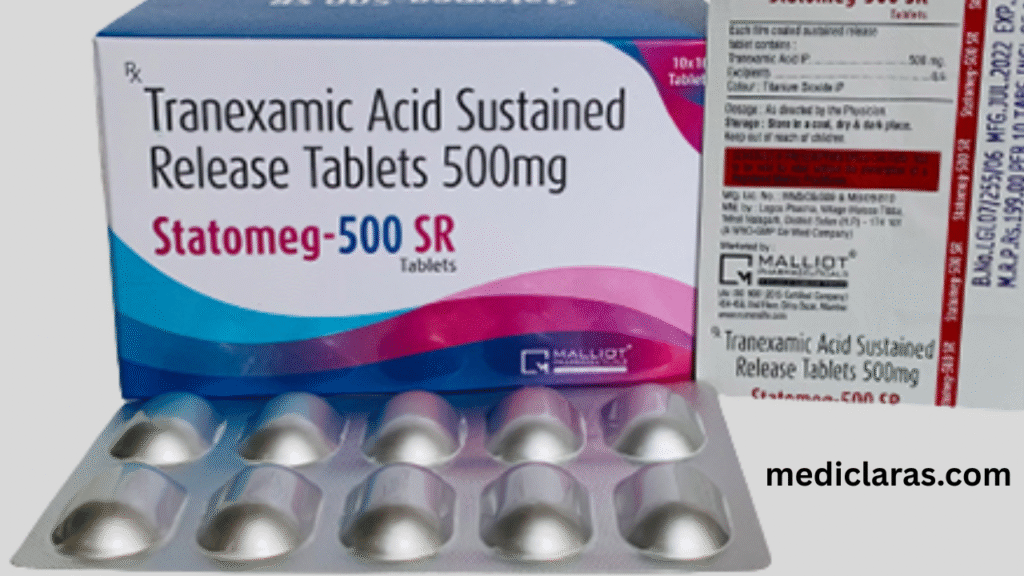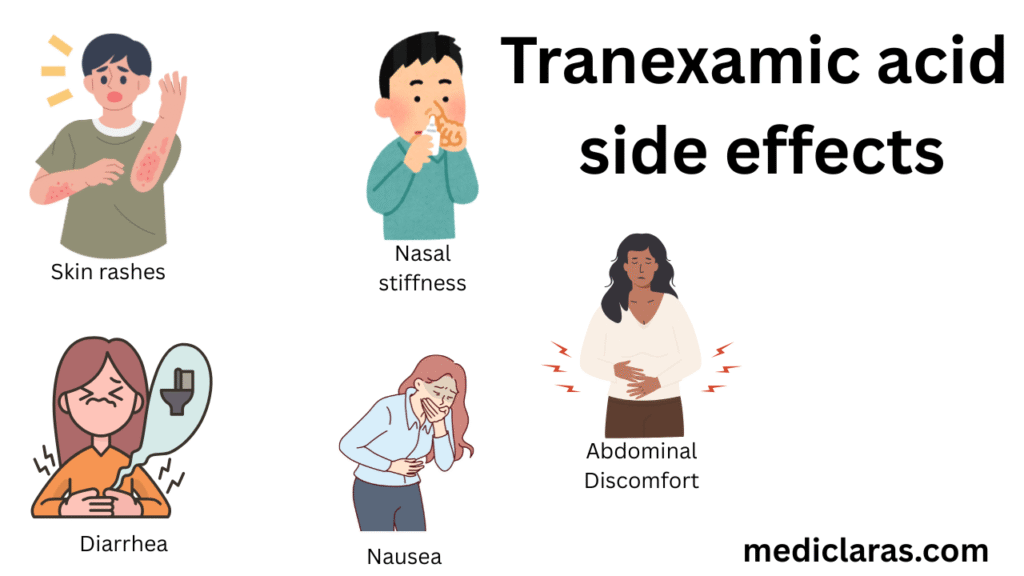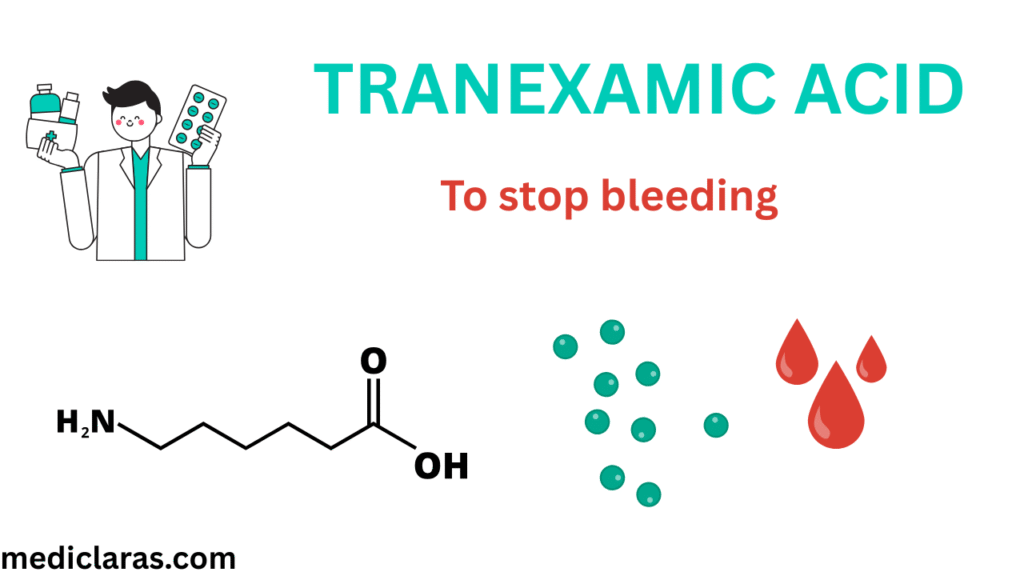Tranexamic Acid Uses And Side effects You should Know
Tranexamic Acid assists in the control of bleeding. Emerging studies
Indicates it has the potential to be a good skincare componenet and could
be especially beneficial for treatment of dark spots and
hyperpigmentation as well as just brightening skin .
Tranexamic acid or TXA as some prefer to call it – is a medication that
helps in blood clotting. Again this is the only indication for which TXA is
commercially available at this time but there are several lines of research
that support off-label uses in dermatology. In this article we should learn
about tranexamic acid uses and Side effects you should know.
What is Tranexamic Acid?
Tranexamic Acid is a manufactured compound originating from the
amino acid lysine. It is a fundamental medicine in the management of
antifibrinolytic therapy and hemostasis. Its introduction and development
has revolutionized the management of bleeding disorders, surgical
procedures and management of trauma.
Brand Name
Try to see if Tranexamic acid falls under the following brand names:
● Cyklokapron
● Lysteda
Generic Name
Its generic name is Tranexamic Acid.
Tranexamic acid available in following forms:
● Oral tablets
● Injections
● Mouthwash

Tranexamic Acid Uses
As a drug with a range of medical applications, tranexamic acid is important for managing
to its antifibrinolytic effects. The main application of tranexamic acid uses is to help manage and stop excessive bleeding in different clinical situations.
The following is a list of more common tranexamic acid uses:
Excessive Menstrual Flow
Excessive Menstrual bleeding is common. It occurs in many women and
Presents a possibility of causing anemia and impacting life quality negatively.
Tranexamic acid is frequently recommended for the treatment of heavy
menstrual bleeding to decrease blood loss. Tranexamic acid acts to
stabilize the clots of blood that form in the internal lining of the uterus
endometrium , during menstruation which decrease the amount of blood
loss over the course of menstruation.
Trauma
Tranexamic acid was shown to reduce all cause mortality in patients with
substantial bleeding from trauma . Tranexamic acid is administered in
emergency situations of major trauma like from car accidents to stop
excessive bleeding. The time of administration is important. It
delivers the most advantages when given quickly, ideally within three hours of substantial trauma.
Tranexamic acid also reduces the chances of death from injury when
given within the initial 3 hours of our brain injury.
Surgical procedures
Surgical teams commonly use tranexamic acid to limit bleeding before
and after operations.
● In orthopaedic surgery, tranexamic acid is sometimes employed to
accelerate bleeding prevention and is so effective in circumstances
that it has reduced or eliminated the need for perioperative blood
transfusion. It assists in maintaining a clean surgical area,
reducing bleeding when used either before or after surgery .It
reduces the duration of drain placement and number of
transfusions.
● In surgical management of craniosynostosis in children,
tranexamic acid has decreased the need for blood transfusions.
● Consider spinal surgery for scoliosis where tranexamic acid
is implemented in conjunction with posterior spinal fusion and instrumentation for the core
in order to decrease blood loss.
● In order to control excessive bleeding during cardiac procedures, tranexamic acid is used in both the presence
and absence of cardiopulmonary bypass.
e.g. coronary artery bypass surgery.
Dental Procedures
For short term tranexamic acid is used in those with severe bleeding disorders
prior to dental surgery. It’s possible to use tranexamic acid for a little while prior
to surgery and for a few days afterwards, to prevent serious blood loss
and it can also help in reducing blood transfusions.
Nosebleeds
Tranexamic acid, used topically applied to the bleeding tissue or by
mouth, is effective in stopping nosebleeds as compared to the nasal
packing with cotton pallets only. Tranexamic acid reduces the rate of
rebleeding within 10 days.
Hematology
There is insufficient evidence to recommend tranexamic acid for
bleeding prevention in patients with blood cancers routinely. However ,
many studies are currently evaluating these indications for tranexamic
acid. It is sometimes given to the patients with inherited bleeding
disorders like von Willebrand’ s disorder. Generally prescribed
For those with bleeding disorders acquried later in life needing treatment for significant
bleeding.
Childbirth
A common postpartum treatment involves administering tranexamic acid with oxytocin
minimize bleeding. It’s important to note that rare cases of death in women have been documented where tranexamic
acid was used.
Cosmetic Applications
Skin care products may contain tranexamic acid that is beneficial to
minimise the look of redness and uneven skin tone. Tranexamic acid is
an amino acid that exists as zwitterion, which has some low permeability
coefficient of assimilation in the stratum corneum.
Tranexamic acid can be used with micro needling and penetration
enhancers to work against the low permeability of tranexamic acid.
Tranexamic Acid Side Effects
Typically tranexamic acid is well tolerated and beneficial in prevention
and management of excessive bleeding. As with any medication some
Tranexamic acid uses can sometimes lead to side effects. Side
effects can be mild to severe and it’s important to know about tranexamic acid side
effects to properly manage them and discuss them with the health care
professionals if necessary. Side effects are grouped as common less
common and rare which are following:

Common Tranexamic Acid side effects
Tranexamic Acid may cause minor side effects. As your body adjusts to
the medication the side effects may fade.
Some of the common tranexamic acid Side effects includes:
● Stomachache or distress
● Diarrhea
● Nausea
● Vomiting
● Significant headache
● Pain in back or joints
● Fever
● Chills
● Muscle discomfort
● Rigidity in muscles
● Nose feeling blocked or watery
● Reduce range of motion
Usually common tranexamic acid side effects do not require watching by a doctor.
Talk to your doctor if you have worries about these side effects . He or she
Might be able to inform you and assist in reducing or
avoid common tranexamic acid side effects.
If you develop any side effects that are not listed, please call your doctor.
Less common tranexamic acid side effects
Allergic Reactions like:
● Facial,lip or tongue swelling
● Feeling itchy
● Skin rash
● Difficult breathing
● Tiredness
● Vision problems
● Changes in color vision
● Unusual weakness
● Visual field deficits
Serious Side Effects
It’s important to be aware of these rare but serious effects of tranexamic acid :
Blood Clots
Tranexamic acid may increase your chances of developing blood clots in artries or veins. It might
lead to a stroke, or other blood clot disorders specifically a venous thromboembolism
your lungs or have deep venous thrombosis. If you observe any of
these signs of blood clots , inhibit tranexamic acid use and
get emergency help.
Eye problems
Tranexamic acid has been linked toa serious eye inflamation called conjunctivies.
if you have develope the following symptoms , stop the medication and immmediately
consult your healthcare provider:
Red,itchy,or painful eyes
Swelling on eyelids
Dry,watery eyes
Changes in vision
Contraindications For Tranexamic Acid Uses
Known sensetivity to any of the components or an individual allergy to any ingredient
should avoid taking tranexamic acid.
Contraceptives : Tranexamic acid should not be used if you are currently taking any form of contraceptive or
birth control that has both an estrogen and progestin.
If you have experienced blood clots in the past or have them now
avoid using tranexamic acid.
If you have had a blood clot in the past or a condition that would increase your
conditions like cancer or artial fibrillation can increase your susceptibility to blood clots.
In Kidney Problems
Frequently asked questions
Does tranexamic acid clear skin?
Yes, tranexamic acid can assist in clearing the skin by reducing the
appearance of hyperpigmentation and uneven skin tone.
What do we know about safety of using tranexamic acid for a long time period?
Tranexamic acid is generally used to treat bleeding for a short time
period.
What should be avoided with tranexamic acid?
For the most part you can take tranexamic acid with other medications . However if
you take the combined contraceptive pills, you should discuss this with
your doctor or pharmacist. Using tranexamic acid and hormonal contraception together
may slightly raise your risk of developing a blood clot
pill at the same time.


